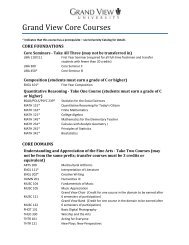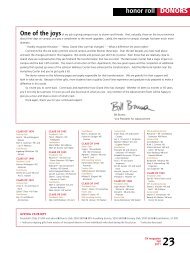MUNINN
MUNINN - Grand View University
MUNINN - Grand View University
- No tags were found...
You also want an ePaper? Increase the reach of your titles
YUMPU automatically turns print PDFs into web optimized ePapers that Google loves.
The Treaty of London (1838) <strong>MUNINN</strong> Volume 2 (2013)consensus between the original signatory powers of 1839 that offereduniversally accepted interpretations that “guaranteed” Belgianneutrality in the 1914 context. In fact, it was widely known that in1887, British Prime Minister Lord Salisbury (Robert Gascoyne-Cecil,1830-1903) “had been prepared to sacrifice” the 1839 treaty. 4Considerable shifts of the meaning of “neutrality” and “guarantee” hadtaken place between signatory powers like France, Britain andGermany. At every major crisis that directly threatened Belgian“neutrality” between 1839 and 1914, reinterpretations of “guarantee”and “neutrality” were made and remade. This paper argues that Belgianneutrality as guaranteed under the 1839 treaty may no longer have beenunderstood the same way by any of the signatory powers in 1914,including Great Britain. Yet, the 1839 treaty was dusted off and usedfor a declaration of war and at the Treaty of Versailles in thepunishment of Germany. It should be noted that this paper does notdefend German aggression nor will it seek legitimacy for the Germaninvasion of Belgium, but it merely questions the manner in which the1839 treaty was used against Germany.Treaties are often viewed as “expression[s] of conditions andrelationships of power in existence at the time of their making” and yet,“they cannot hope to freeze forever the status quo of any particularmoment of time.” 5 The Treaty of 1839 is no different, so in order tounderstand the impact of the burden of responsibility that the Treaty of1839 placed on the signatory powers, a concise historical backgroundof its origins is necessary. Knowing the circumstances that led to thecreation of this treaty helps us to understand its misapplication in 1914.We need to know the intent behind Article I of the Treaty of 1839 thatheld the “guarantee of their said majesties,” as well as Belgium’s“independent and perpetually neutral state” as established within theannex portion of Article VII. 6The origins of the Treaties of London 1839 can be traced backto the end of the Napoleonic wars (1803-1815) with the Congress ofVienna. 7 In 1815, Holland and Belgium were combined into onenation. 8 Continual strife led to a Belgian revolt on August 25 th 1830. 94Max Montgelas, “The Case for the Central Powers Article 16,” The Outbreak of WorldWar I: Who Was Responsible? Dwight Lee, ed. (New York, Random House, 1977), 7-8.5Rene Albrecht-Carrie, A Diplomatic History of Europe Since the Congress of Vienna(New York: Harper & Row, 1973), 7.6Treaty of London 1839, Article I, quoted in Sanger and Norton, 126.7The Napoleonic wars were a series of wars and or other conflicts that was primarilyfought on the European continent and on the high seas, involving such belligerents asFrance, Britain, Russia and Prussia.8The Congress of Vienna was convened to deal with the aftermath of the Frenchrevolution and the Napoleonic wars which resulted in a drastic restructuring of Europe.9Sanger and Nelson, 7-8. The irony is that the Belgium revolt happened because of theFrench revolt, and the timing also affected the Polish revolution.26







